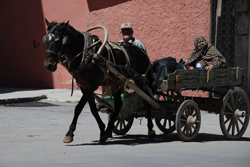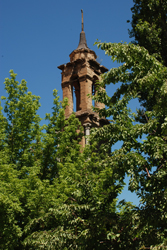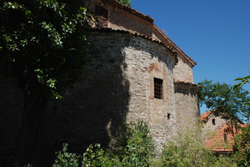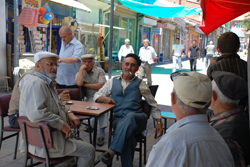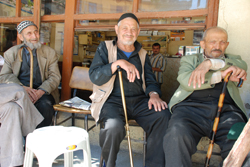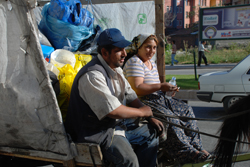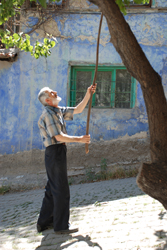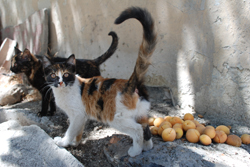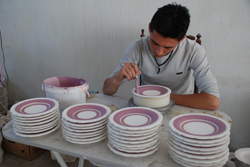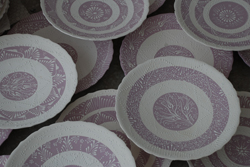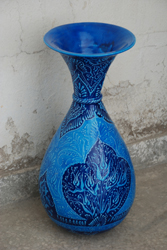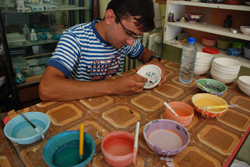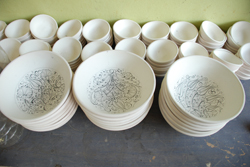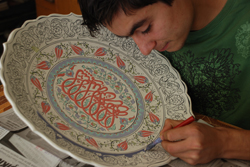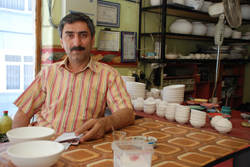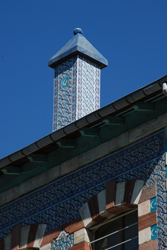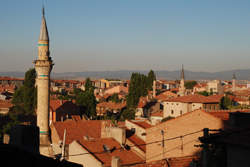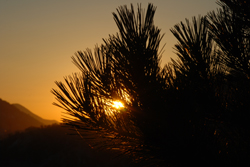Ceramics in Kutahya
14 July, 2008, 02:07 am in "Turkey"
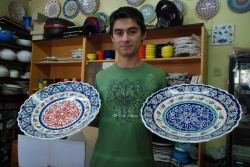 Rowshan had determined that he really wasn't interested in seeing the ceramics factories here. It looked like they mostly made mass produced porcelain dish sets and tea pots.
Rowshan had determined that he really wasn't interested in seeing the ceramics factories here. It looked like they mostly made mass produced porcelain dish sets and tea pots.After some questioning, however, he found out there were still some small family workshops in one part of town. We boarded a bus that brought us to an area at the foot of the fortress. We'd been looking down on that area the day before. The bus passed a couple storefronts where we saw some ceramic pieces in various stages of completion. We weren't sure if there was another place where they were more concentrated so we rode the bus a few more blocks to the hospital. Then we walked back. It was another quiet neighborhood with fruit trees and old houses mixed with modern ones. A man delivering jars of milk from a horse drawn carriage passed us. His wife, dressed in shalvar pants and modestly covering her face with a veil, rode in the back.
We came to the ruins of what was probably a Byzantine church and then saw a promising looking ceramics workshop specializing in decoration.
Unfortunately it was closed. A man came up to us and asked if we needed help. When we said we were interested in the shop, he said they would be open in the afternoon. We've found the people in Kutahya to be very helpful and friendly. When Rowshan asks questions, they always try to help. Sometimes, seeing we are foreigners, they come up and ask Rowshan what he is doing, where he is from, etc. When Rowshan asks permission to take photos, people not only say, "Yes," but seem flattered and happy that he wants to photograph them.
I think Rowshan is really enjoying talking to so many new people and taking so many photos.
As we walked back down the street. The man who told Rowshan to come back in the afternoon was using a long stick to knock apricots off a tree.
He offered us some. Rowshan chatted with him and learned he was from Macedonia. Later some cats (including 2 apricot colored ones) climbed from the roof down the tree.
We walked back down to the first ceramics places we'd seen from the bus. Rowshan was able to pump the people working there for technical information and they seemed happy to hear about Peruvian, American, and Moroccan ceramics techniques. They were working on decorating pieces that when fired became pretty blue and turquoise colors.
We returned to the ceramics workshop across from the apricot tree, Inan Çini Decor, and saw 2 young men working. They welcomed us and showed us what they were doing. Both were painting tezhip designs.
One, Yasin, explained how the outlines were painted on by women who worked at home, using templates. Though sometimes they painted smaller designs on smaller pieces freehand from memory or making new designs.
The other, Talha, was busy working on decorating a huge plate which would take 2 days to finish.
They were both students but worked in the shop for the summer. It was a family business run by their fathers who were brothers. Yasin, showed us the workshop across the street where they had stacks of plates drying as well as kilns. We went back to the shop. The cats from outside had wandered in and draped themselves on shelves and chairs. One of the shop's co-owners, Aladdin joined us and a young assistant brought tea. We sat down and Rowshan and him had a long talk about ceramic techniques.
He was passionate about the subject and very interested in historic techniques. He used to live in Istanbul and worked for the government doing surveying before construction was permitted: a crazy job in Istanbul where everywhere you dig you hit some ancient structure, or archaeological treasure. While he was there he spent some time in ceramic workshops for the Çiragan and Yildiz palaces where they made pieces for the restoration of the palaces and studied archaeological evidence. While watching a worker put glaze on a bowl, he said, "The bowl is not accepting the glaze." They had been drinking tea and he mixed a bit of pigment with his tea, and said, "Now glaze it." Later the worker thanked him saying, "That bowl turned out really well." The point of the story was that one of the reasons it is so hard to reproduce ancient ceramics glazing techniques is there were just so many possible combinations and no way to figure out what the exact ingredients or process was. He talked about how much knowledge had been lost. "Sir" (with a short i) is the word for glaze but also means "secret". The secret of Iznik red is lost and no one has been able to reproduce it. He believed that the ingredients in the glazes, clay, and even the arrangement of the pieces in the kiln caused a harmonious reaction which caused unique results. The ceramic artists of the past, knew how to create these harmonious reactions. They also gave the pieces time to dry. "Now everything is done quickly and many pieces end up broken or deformed. Sometimes," he said, "chips break from the surface of pieces after a long time. This doesn't happen with the old pieces. " Aladdin believes this is because the pieces aren't given enough time. His whole family makes ceramics. He also told us about how Turkey, Iran and Syria had the highest technical levels of ceramics in the region. He and his brother also made kilns. We enjoyed listening to his descriptions and stories and Aladdin, in turn, enjoyed seeing Rowshan's photos of Peru and Safi, surprised to see that in Safi they were using techniques they had used in Turkey ages ago.
Happy to have accomplished what we originally came to Kutahya to do, we walked back into town then wandered over to the courthouse, a historic building, where I relaxed on a bench and wrote while Rowshan took more photos.
Since our bus isn't until 1:30 AM, we have a lot of time to kill. We printed out some photos and brought them back to the workshop, then walked up one of the hills overlooking the town. The sun was beginning to set and cast a golden light over the white earth of the hills.
We walked through the fragrant pines and watched the sun go down.
In the distance we could hear saz and vocal music. The town wound below us between the hills like a river, before it spread out across the flat lands. We could see the turquoise minaret and domes of the Çinili Mosque. We walked back down the hill into town and went to a gözleme restaurant for dinner. There we met Ayhan, whose family owned the place. He worked as a waiter in the evening. He sat down with us and we talked about America and Istanbul (where he went to school). He joined us for the whole dinner which, thankfully, was delicious, probably the best gözleme I've had.
Comments
- Comments


